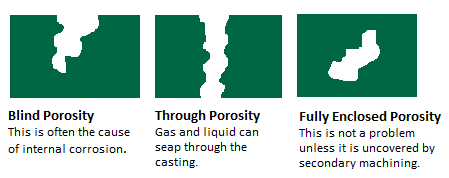We are sometimes told by customers that they are unaware of what vacuum impregnation is. Ultimately, they have a casting with porosity that is leaking whatever is passing through the part (i.e. air, gas, water, etc.), and they need a solution to their problem. Here are some of the more common questions that we receive in regards to vacuum impregnation and porosity. Our intent is that you can use this information as a guide when you need to correct castings with porosity.
Would you like this information in a printable form? Of course! Click here to download it as a pdf.
What is porosity?
Porosity is an area of sponge-like texture in an otherwise sound metal casting. There are two types of porosity:
- Micro-porosity: Very small (almost invisible) interconnected air filled cells.
- Macro-porosity: Larger flaws in the casting visible to the naked eye.
Porosity is typically caused during the casting process by internal shrinkage, gas cavitation, oxide films and inclusions and the many combinations thereof.
What is vacuum impregnation?
Vacuum impregnation (also known as "impregnation" and "impreg") seals the porosity in metal castings, thus making leaky castings pressure tight.
What is the process of vacuum impregnation?
In a nutshell, the impregnation sealant is introduced into the voids within the wall thickness of the casting through vacuum and/or pressure methods. Subsequent processing solidifies the sealant.
What are the types of porosity?
There are three types of porosity:
- Blind Porosity: From one surface only and therefore not forming a continuous passage for liquid
- Through Porosity: Stretching from one inner face to another thereby causing a leakage path
- Fully Enclosed Porosity: This can not be reached by impregnation.

How does impregnation improve product quality?
When casting porosity is reviewed during inspection, "good" castings are as porous as the "bad" castings because the porosity is blind and not completely inter-connected. Subsequent mechanical or thermal shock or stress often breaks the thin membrane in the "good castings" which keeps the blind porosity from being continuous, thus causing a "leaker". Impregnation fills porosity from both sides preventing leaks even if the membrane does break. Therefore, impregnation salvages castings and improves quality, while inspection only sorts out leakers.
What materials can be impregnated?
All ferrous and non-ferrous metals, whether sand cast, gravity die, pressure die castings or forgings can be impregnated to eliminate porosity. Iron, bronze, aluminum, zinc, magnesium, steel, sintered metals and plastics, as well as alloys of these metals can be impregnated.
Can cracked castings be fixed through impregnation?
No. Impregnation will not increase the strength of a casting. The cracks will reopen when the casting is under pressure.
Can vacuum impregnation cure surface flaws?
No. This is because impregnation is within the part and not a surface treatment.
Should impregnation occur before or after machining?
Impregnation occurs after a casting is machined. This is because machining may potentially uncover additional porosity.
Will impregnation discolor or damage the casting?
No, because impregnation occurs within the walls of the casting. There is no film or coating on the part surface that will change any dimensional tolerances.
These are not the only questions we receive in regards to vacuum impregnation and porosity.
To discuss your specific questions, or situation, contact us at 330-562-1440 or send us an email.
Next Steps
- Talk to us about what services are right to you.
- Understand porosity and vacuum impregnation by downloading our handbook.
- Stay connected and become an expert on porosity and vacuum impregnation by subscribing to our blog.



